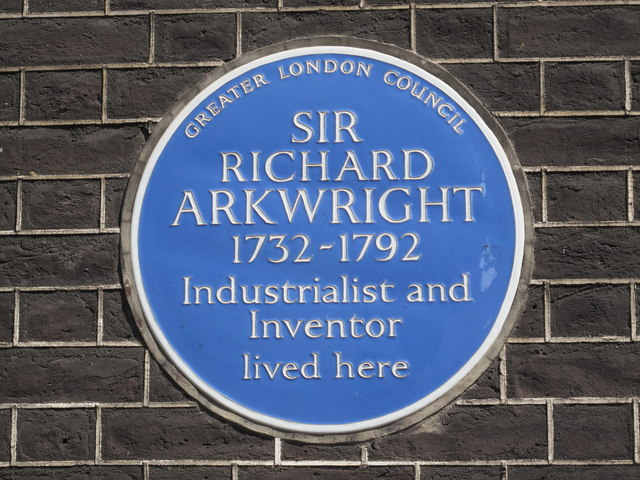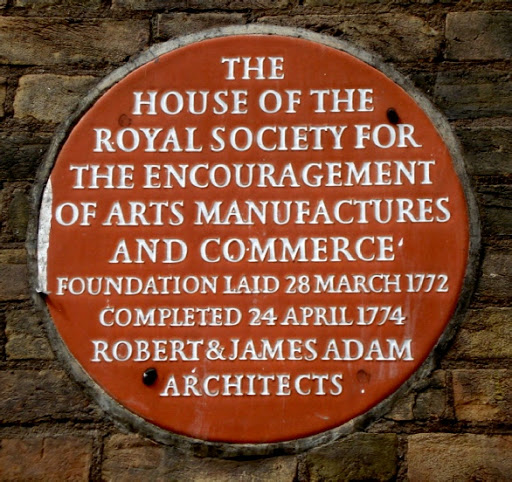You see blue plaques dotted all over Britain, commemorating such-and-such a famous person who lived in a building. They seem, at first glance, just a nice reminder of history.
But that was not their original purpose. And nor were they always blue. A thread.
But that was not their original purpose. And nor were they always blue. A thread.
The idea began in the 1860s, with the utilitarian MP William Ewart. His claim to fame, in the 1850s, had been to pass laws enabling local authorities to raise taxes to pay for public museums and libraries.
And with the plaques, he had similar educational aims.
And with the plaques, he had similar educational aims.
Ewart proposed in Parliament that signs of some kind be erected to celebrate people who had done things to advance the arts, sciences, and culture. Politicians and generals, after all, got plenty of statues. By celebrating the arts of peace, those activities would be encouraged.
But Ewart& #39;s proposal did not originate the blue plaques, though they likely inspired them. Instead, they came from a member of the Society for the Encouragement of Arts, Manufactures and Commerce - Britain& #39;s de facto improvement agency (now @theRSAorg).
https://www.amazon.co.uk/Arts-Minds-Society-Changed-Nation/dp/0691182647/ref=tmm_hrd_swatch_0?_encoding=UTF8&qid=&sr=">https://www.amazon.co.uk/Arts-Mind...
https://www.amazon.co.uk/Arts-Minds-Society-Changed-Nation/dp/0691182647/ref=tmm_hrd_swatch_0?_encoding=UTF8&qid=&sr=">https://www.amazon.co.uk/Arts-Mind...
That member was George Bartley, a civil servant. Bartley, like so many others, used the Society of Arts as a platform to pursue policies well beyond his job remit.
(His boss and father-in-law, Henry Cole, had done just the same to organise the famous Great Exhibition of 1851)
(His boss and father-in-law, Henry Cole, had done just the same to organise the famous Great Exhibition of 1851)
But Bartley& #39;s aims differed from Ewart& #39;s too. In 1866, when he proposed memorial plaques be put up all over London, his concern was for the buildings themselves, not celebrating the people who had lived there.
The problem, as he saw it, was that old London was being demolished.
The problem, as he saw it, was that old London was being demolished.
London, Bartley feared, was quickly becoming uglier, with landlords (no planning permission back then) tearing down whatever they pleased. The old, beautiful buildings had to be "preserved from the ruthless hands of modern destroyers and improvers".
His solution was plaques.
His solution was plaques.
Advertising buildings& #39; historical associations would, Bartley hoped, make landlords think twice before tearing them down.
He hoped that historical associations would become a valuable *selling* point, at a time when new buildings were almost always considered better.
He hoped that historical associations would become a valuable *selling* point, at a time when new buildings were almost always considered better.
At Bartley& #39;s urging, the Society of Arts sprung to action by compiling a huge list of historical figures& #39; abodes. The idea, initially, was that the list alone would encourage owners to put up their own signs.
But there was little response, so the Society did it themselves.
But there was little response, so the Society did it themselves.
They commissioned the potter Herbert Minton, an old friend of Bartley& #39;s father-in-law Henry Cole, to produce the kinds of plaques we& #39;re so used to today.
The first two went up in 1867, showing the birthplace of Lord Byron and the residence of the French emperor Napoleon III.
The first two went up in 1867, showing the birthplace of Lord Byron and the residence of the French emperor Napoleon III.
Those earliest plaques were blue, just like today. And you can tell they were Society of Arts ones because it says so if you look closely at the intricate border pattern.
But the blue pigment was rather expensive, so they soon switched to a chocolate brown:
But the blue pigment was rather expensive, so they soon switched to a chocolate brown:
In all, the Society of Arts put up 35 of these memorial plaques, before persuading London County Council to take on the scheme in 1901.
As with so many of the Society& #39;s projects, it initiates them but then hands them on to others, so that it can move onto new things to improve.
As with so many of the Society& #39;s projects, it initiates them but then hands them on to others, so that it can move onto new things to improve.
Since then, of course, the Blue Plaques have spread beyond just London, becoming a nationwide institution. They soon returned to the original blue, and since 1986 have been run by English Heritage.
But, unfortunately, they weren& #39;t always as successful as Bartley had hoped.
But, unfortunately, they weren& #39;t always as successful as Bartley had hoped.
Of the 35 buildings with Society of Arts plaques, almost half were nonetheless destroyed. Even the building with the very first plaque, for Byron, lasted only a couple more decades.
Proper preservation would take more active measures, and legislation. But persuasion was a start.
Proper preservation would take more active measures, and legislation. But persuasion was a start.
So as you walk London& #39;s streets, if you spot a blue plaque, and especially a brown one, spare a thought for the work of Bartley and the Society of Arts to keep those buildings still standing.
And for more on this truly remarkable Society, see my book: https://www.amazon.co.uk/Arts-Minds-Society-Changed-Nation/dp/0691182647/ref=tmm_hrd_swatch_0?_encoding=UTF8&qid=&sr=">https://www.amazon.co.uk/Arts-Mind...
And for more on this truly remarkable Society, see my book: https://www.amazon.co.uk/Arts-Minds-Society-Changed-Nation/dp/0691182647/ref=tmm_hrd_swatch_0?_encoding=UTF8&qid=&sr=">https://www.amazon.co.uk/Arts-Mind...

 Read on Twitter
Read on Twitter





